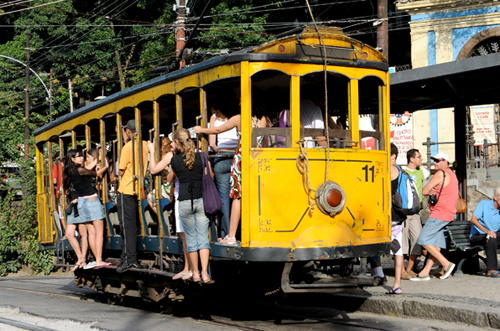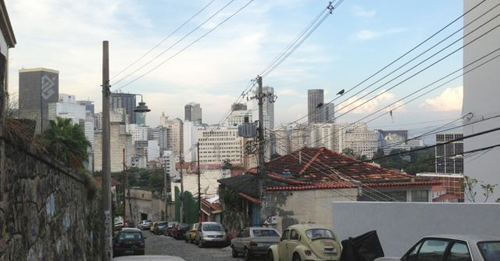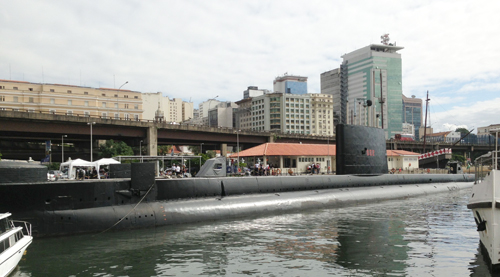The three of us took a trip to explore the Santa Teresa section of town. This is a charming and very old Rio neighborhood, built on a high mountain that rise abruptly from the city's center.
From Wikipedia
The Santa Teresa neighborhood originated around the Santa Teresa Convent, built in the 1750s on the Desterro hill. At the end of the 19th and early 20th century it was an upper class borough, as testified by its magnificent mansions, many of which are still standing.
In 1896, the Carioca Aqueduct, a colonial structure that used to bring water to the centre of Rio, was converted into a viaduct for the Santa Teresa Tramway (bondinho). The historic tram line - the only remaining one in Rio - is a popular attraction among tourists. The ride starts in the city centre, near the Largo da Carioca square, crosses the old aqueduct and goes through the picturesque streets of the neighborhood. Wonderful views of the city downhill can be appreciated. Five people were killed at least 27 injured when a tram derailed in August 2011 and the service has been indefinitely suspended since then.
A ride on the Santa Teresa trolley (called the “bondinho” in Rio) is like a journey through time. At the bondinho’s main station in Centro at Largo da Carioca, a quick look around gives a foretaste of Rio’s future.
We caught a small bus because the tram is no longer running.
I decided to try and find a bus to the top of the hill (since the historic tram, Bondho, is no longer working) All you have to do is turn a few corners and you're faced with almost impossible walk up some very very steep hills.
We were lucky we found a small bus to get to the top of the neighborhood and we easily walked down taking the pictures all along the way. We would never have been able to walk up on our own steam.
Additionally the whole area has become an object of revival and there are excellent restaurants dotting the area. We looked forward to having a great lunch there as well.
View from the bus stop at the top of the hill.
More views from the top of the hill.
More views from the top where we got off the bus.
Many houses are currentky being restored.
A mural showing the old Bondho.
The whole area was really made livable because of the Bondho that ran across the famous Lapa aquaduct and up the hill. The easily recognized trolly was bright yellow, had open sides and wooden running boards. It had been made even more famous by the 1959 Oscar award winning movie "Opehus Negro". As mentioned above tragic accident about a year ago killed five people and they closed the long neglected line (my cousin tells me he remembers trollies going everywhere in Rio). The city of Rio and national government declared it of historic and national importance and plan to reopen it again under management of a Portuguese company that runs trams in Europe. I still remember how much I enjoyed riding on it the last time I was here.
A recently restored home.
After taking the subway, we caught a small bus that climbed the cobblestone streets up the hill. We got off where the bus turned to go up another hill. From there we were high up above the city, The Santa Teresa neighborhood was once a very wealthy section of Rio (as seen in the huge mansions throughout the area) that had fallen into disrepair.
An exclusive boutique hotel just opened and some of the neighbors, whose property values (and their taxes) have gone up dramatically are continually trying to have it shut down (the harried manager told us).
Many mansions are in terrible disrepair.
Some large mansions are up for sale.
Many are in the process of being restored.
A hillside Favela is just below the street level.
The hillside also has a Favela clinging to its side. The two cultures seem to coexist side by side. The whole neighborhood is slowly going through a restoration process house by house.
The courtyard of an exclusive new hotel.
A Moroccan themed bar and restaurant is at the hotel.
The vistas of the city kept peeking out between the houses as we walked. They were built clinging into the steep hillside. Some simple houses had incredible structures holding them up. Some looked like major concrete bridge structures.
This structure was built like bridge.
We passed a lot of graffiti and wall art that has become an important feature throughout Rio.
This simple two story house had a vast concrete structure below it.
A movie theater.
As we descended, the older commercial area came into view. One old building was changed into a small movie theater showing that latest US releases.
People park anywhere.
Goat cooked Northeastern style.
We came to the restaurant area and found a place offering Northeast Brazilian delicacies. Outside they had a sign in the window showing their goat dish. That's all I needed to see.
One of the old tram station.
We descended further, asking directions for LAPA. Soon we found ourselves on a very steep street with the major metropolitan cathedral and high office buildings straight ahead.
It seems our trip through Santa Teresa had come to an abrupt end. We found ourselves back downtown at the Cinelandia Square and the Metro station. And soon found ourselves home.
Downtown appears behind the turn. The Metropolitan Cathedral is seen at right.
Downtown Rio is right ahead.
The Lapa aquaduct.
Wall art Downtown.
The historic Lapa Aquaduct.
Lapa is still rather run down.
The Lapa aqua duct and the cathedral.
The Rio opera house and the Cinelandia square.








































































